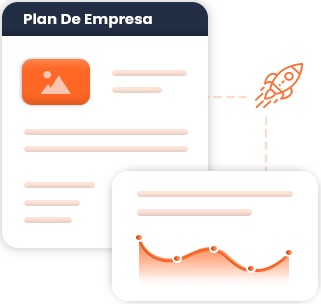Starting on a blank doc to craft a business plan is often intimidating for most business owners. It’s even difficult for people who’ve never written a business plan before. Wait, these business plan examples can help!
Viewing some examples can guide you in creating your own as you can visualize what your complete business plan would look like—an inspiration, if you will. As you go over these examples, you’ll slowly get familiar with the structure of business plans and understand the kind you need for your industry type.
Explore our extensive collection of sample business plans to find one that fits your requirements.
Sample business plan format
A typical business plan often has a basic and straightforward format, like the following:
1. Executive summary
An executive summary is an overview of everything that you’ll discuss in your business plan, so it’s the first section. It’s brief (typically a page) but effective in making a first impression so that investors or readers want to continue reading your plan.
It will contain the problem you intend to address, the kind of service or product you plan to launch, an analysis of the target market and marketing strategies, and a punchy conclusion.
2. Company overview
This is a summary and identification of your new organization. You can use this section to introduce readers and potential investors to your beloved company by outlining its core values and goals.
Company overview is typically passionate and consists of data like your company’s history, your team, your location, the business structure, who you wish to cater to, goals, objectives, and your product or service.
3. Market analysis
Market analysis is a thorough assessment of your target market and competition in your industry. It helps businesses realize the strengths and weaknesses of their own as well as their competition.
Here are the main contents of the market analysis section:
- Industry analysis to get an idea about the industry environment you’re about to enter
- Target market analysis to identify and quantify the customers that you will be selling to
- Competitive analysis to identify your competitors and see where they excel or tank.
4. Product and services
Here’s the meat of your business plan. In this section, you can talk about the product or service you plan to sell to your target market.
Importance?
It’s the essence of your business as everything revolves around the product or service you intend to provide.
In general, this section includes:
- Description of your product or service and explanation of how it benefits your target market
- Explanation of how your product or service will beat competitors
- Prototype data and images
- Copyright, patent, or trade secret data
- Research on future new products and services
- How your products and services will be priced
5. Sales and marketing strategies
This next section helps you reveal how you intend to make sales and market your business or solution to customers. Your sales and marketing strategies show your reader how you will spread the word to your potential customers to sell your product or service.
Here’s everything a reader expects to find in this section:
- Your game plan to promote your business to customers
- How you intend to gain more customers
- Data regarding costs, pricing, promotions, and distribution
- An explanation of how your product will go from acquisition or production to delivery
- Information on sources of labor
- Data regarding distribution such as inventory management, logistics, and distribution channels.
6. Operations plan
As the name suggests, this section provides an overview of your overall operations such as workflow and supply chains.
You need this section to help investors and stakeholders understand how you’ll deliver on your promise to turn a profit. This means, daily, weekly, and monthly operations.
That’s why the operations plan typically includes:
- Step-by-step depiction of the production workflow
- Introduction to your suppliers
- Quality control measures
- Equipment and assets involved in operations
- Time taken to produce your product or complete your service
7. Management team
This section is where you can get braggy about your management team and introduce the key members. It’s mainly to prove you have THE team to succeed in the business you are promising.
Such information makes it easy for investors to trust in a business because it shows competence.
You can include details about each member like their role, skills, experience, education, and background.
8. Financial plan
Money makes the world go round. Hence this section is crucial as it thoroughly describes a business’s historical financial state and future financial projections.
Here it’s all about hard facts and numbers. So revealing such information is how you can convince lenders and investors.
What should you include?
- Budgets and financial statements
- Funding requests in this section of the plan
- Budget for expenses
- Financial predictions
9. Appendix
Finally, we’re at the last section of a business plan, where you can add supporting documentation for the other sections of your plan.
The purpose?
Sometimes you can’t say or show everything in the previous business plan sections. For example, certain licenses or tax returns.
An appendix is where it goes. Here are some more items you can include in the appendix:
- Charts, graphs, or tables that support sections of your business plan
- Executive team resumes
- Credit history
- Agreements or contracts with clients or vendors
- Permits, patents, and trademark documentation
- Product illustrations or packaging samples
- Attorney Contact
How to use a sample business plan to write your own?
It’s quite simple when you can visualize how your complete business plan will look once you’re done writing. Let’s show you how:
1. Select a relevant business plan example from our library
We have an extensive library of business plan examples. So yes, you will be spoilt for choices, but you will definitely find the sample that fits just right for your business needs.
Take your time to explore and make a choice. Make sure it more or less has all the sections you want and the structure is up to your liking and industry standard.
2. Analyze and modify the business plan structure
Once you’ve picked your sample, understand the structure it has, what sections it contains, and if they’re all relevant to your business.
This way you’ll have an idea of the modifications you need to make. Like eliminating the irrelevant sections or adding the ones specific to your company (and missing in the sample). You can do so by importing or copying the sample plan into an editor.
3. Conduct a thorough market research
Before you move on to fill in the relevant details in the exported template, you need to have certain key data ready such as market research.
Conduct thorough market research so you’re aware of your target audience, what they think, and how they think. That’s the only way to keep up with competitors!
The research will also help you complete other sections of the business plan such as marketing and sales strategies.
4. Refer to financial forecasts and reports
Next, refer to your financial forecasts to complete the financial section in your plan. See what kind of data the example has such as budget, balance sheet, startup costs, funding requirement, cash flow projections, and more.
Then make a note of how they’ve represented the financial data, what revenue stream they’ve included, what kind of assets are they considering, the type of graphs or charts they’ve used, and other details.
This will help you understand the industry-specific financial aspects you need to build a realistic financial section.
5. Prepare the first draft of your plan
Totally equipped with all the necessary data and tools, you can finally start drafting your plan. See how each business plan section is written in the example and write your own in a similar fashion.
Note the details like how long each section is and what kind of information is highlighted. Then edit the sections to reflect your company’s details. Don’t forget to fill in all the business plan sections to complete your draft.
6. Review, edit, and revise your plan
Finally, go over your business plan one last time or ask someone else to review it for a fresh perspective. This will allow you to rectify any mistakes and typos as well as add missing items (if any).
That’s pretty much it. But you can always benefit from some tips. So let’s check out…
Tips for using business plan examples
Here are some tips to make using business plan examples even more effective:
1. Understand the structure
First, you want to get used to the structure of the example plan. See what components make sense to you and how the layout is of a well-organized business plan.
Spot if there are any components you’d like to include but are missing in the example so you can include all sections necessary.
2. Use it as a benchmark
A quality business plan example can be your gold standard. Use it to compare your current business plan and see if you’re lacking anywhere. Spot sections that need more meat and if your quality is at par with industry expectations.
3. Personalize content
If you’ve found THE business plan example that suits perfectly with your company’s requirements, tailor it. Just edit the editing content under each section to reflect your unique business vision, mission, and strategies.
4. Refine your executive summary
Make a solid first impression by crafting a compelling executive summary using the example as a guide. It’ll help you highlight the key points of your business plan making it interesting and captivating for the readers.
5. Modify the content tone and language
Further, personalize your business plan by adjusting the tone and language of the example to match your brand’s voice and target audience for effective communication.
6. Regularly review and update your plan
Use the example to routinely review and update your business plan to align with your evolving business and market needs.
Different types of business plans
You also want to take into account the different types of business plans that exist before you choose an example as your guide:
- Traditional business plan: An elaborate formal document describing your business idea, financial projections, funding requests, operational plan, and more.
- One-page business plan: A summarized version of a traditional business plan.
- Non-profit business plan: This plan describes your non-profit business and what it plans to achieve in the coming five years.
- Internal business plan: This plan consists of all internal goals, objectives, and operations to keep all internal stakeholders on the same page.
- Strategic business plan: A comprehensive document describing a company’s vision, mission statement, and goals, and how the company will systematically achieve what it desires.
The type of business plan you need will depend on your purpose like securing funding, communicating with stakeholders, and more.
Start preparing your business plan
Business plans do a lot: Impress investors, keep stakeholders on track, and help you compete with the competition. So there’s no other option but to create an exceptional plan for your company.
Fortunately, using a business plan example is one of the easiest ways to make the business plan creation process less of a headache. It guides you through the necessary sections creating a well-structured and informative plan. So don’t be shy and explore our template library to find your perfect match today!









